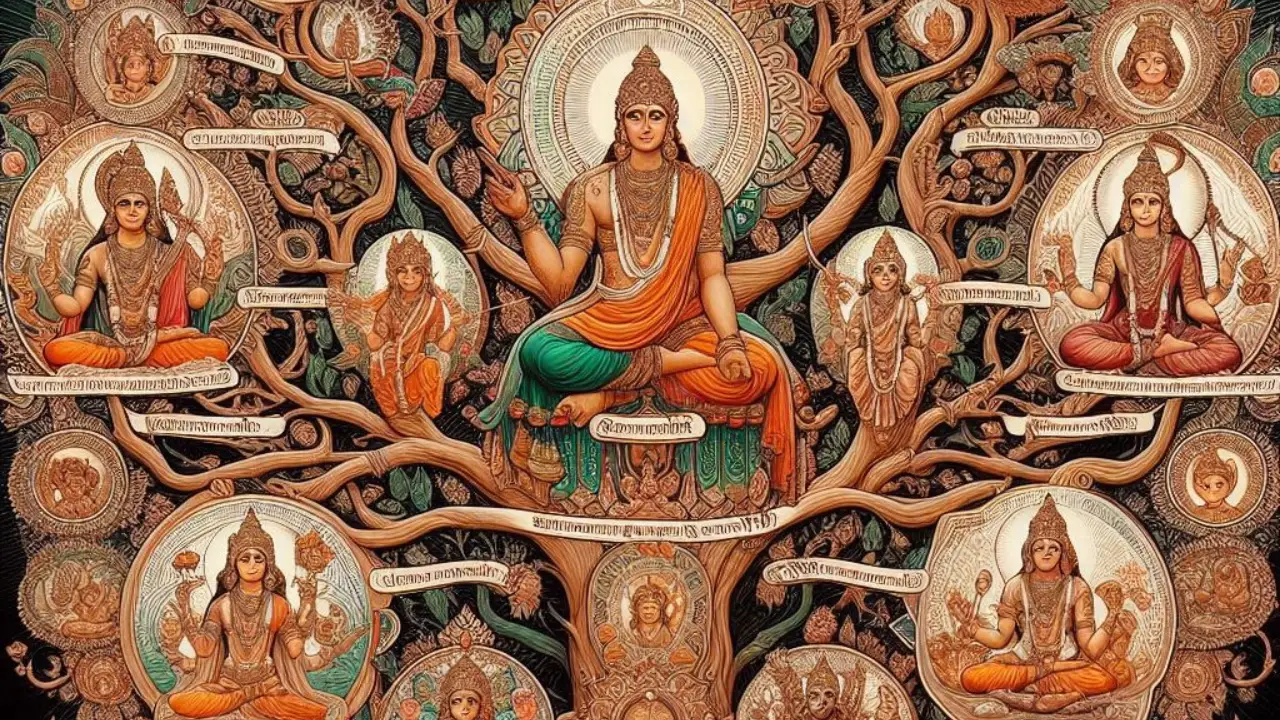Hindu mythology presents a fascinating and intricate web of deities and their descendants. At the heart of this cosmic structure stands Lord Brahma, the creator of the universe and one of the Trimurti alongside Vishnu and Shiva. The family tree of Lord Brahma is not only vast but also filled with significant figures who play crucial roles in various mythological narratives. Let’s delve into the family lineage of Lord Brahma, exploring his consorts, children, and their contributions to Hindu lore.
Lord Brahma: The Creator
Brahma, depicted with four heads and seated on a lotus, is revered as the creator of the universe. According to Hindu scriptures, Brahma was born from a lotus emerging from the navel of Lord Vishnu, symbolizing the divine connection between creation and preservation.
Brahma’s Consorts: Saraswati and Others
Brahma’s primary consort is Saraswati, the goddess of knowledge, music, and arts. Saraswati plays a pivotal role in bestowing wisdom and often depicts playing the veena, symbolizing creative expression. Her association with Brahma underscores the importance of knowledge in the process of creation.
Brahma also associates with other consorts like Savitri and Gayatri. These deities are considered manifestations of Saraswati, each representing different aspects of knowledge and creation. For instance, Gayatri is the personification of the Gayatri Mantra, one of the most revered hymns in Hinduism.
The Progeny of Brahma
The children of Brahma hold significant positions in Hindu mythology. His sons and daughters are often considered the progenitors of various beings and sages. Here are some notable figures:
1. Marichi
Marichi is one of the Saptarishi, the seven great sages. He considers himself the mind-born son of Brahma and is credited with creating the Devas (gods) and Asuras (demons). Marichi’s lineage includes several important deities and sages, making him a vital link in the divine genealogy.
2. Atri
Atri, another of the Saptarishi, is known for his devotion and penance. He married Anasuya, and their children include Dattatreya, a combined incarnation of Brahma, Vishnu, and Shiva, as well as the moon god Chandra. Atri’s family exemplifies the confluence of divine qualities.
3. Pulastya
Pulastya is the father of the demon king Ravana and the sage Vishrava. His lineage highlights the complex interplay between good and evil in Hindu mythology. Pulastya’s descendants are central to many epic narratives, including the Ramayana.
4. Angiras
Angiras, another mind-born son of Brahma, reveres for his wisdom and spiritual prowess. His descendants include many significant sages and deities, contributing to the spread of knowledge and dharma (righteousness).
5. Daksha
Daksha, a Prajapati (progenitor), plays a significant role in various mythological stories, including the tale of his daughter Sati’s marriage to Lord Shiva. Daksha’s actions often set the stage for major events in the Hindu epics.
6. Narada
The divine sage Narada possesses a unique reputation for his mischievous and provocative nature. He travels across the three worlds, spreading knowledge and often acting as a catalyst for significant events in mythology. Narada’s tales are both entertaining and instructional, emphasizing moral and ethical lessons.
The Daughters of Brahma
Brahma’s daughters, though fewer in number in the scriptures, are equally significant. One notable daughter is Sandhya, the goddess of twilight. Sandhya’s role in the daily rituals of Hindu worship underscores the importance of transitional periods in life and nature.
Brahma’s Creation and the Universe
Brahma’s role in creating the universe extends beyond his immediate family. He is credited with the creation of various species, celestial beings, and even time cycles. The myth of Brahma creating the universe from a cosmic egg, known as Hiranyagarbha, illustrates the grandeur of his creative power.
The Legacy of Brahma’s Family
The family tree of Lord Brahma encompasses a wide array of characters, each contributing to the rich tapestry of Hindu mythology. From sages and gods to demons and celestial beings, the descendants of Brahma shape the moral and philosophical narratives of Hinduism. These stories offer profound insights into the human condition, cosmic order, and the eternal struggle between good and evil.
Conclusion
Understanding the family tree of Lord Brahma provides a deeper appreciation of Hindu mythology and its intricate narratives. Each member of Brahma’s lineage adds a unique thread to the vast expanse of mythological tales, enriching the cultural and spiritual heritage of Hinduism.
If this exploration of the family tree of Lord Brahma piqued your interest, leave a comment below and share your thoughts or questions about Hindu mythology. Your engagement helps us delve deeper into these fascinating stories and bring more insights to light.

